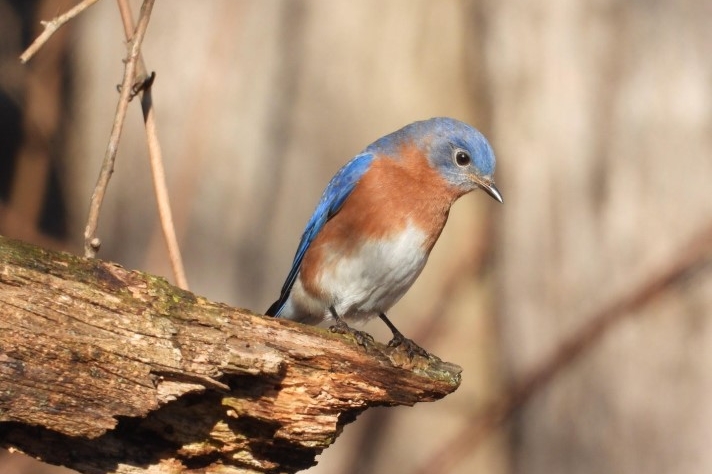Witnessing a Summer’s Story
By Olivia Bautch
Caught up in the throes of fall bird migration, we are occupied with the dull yellows and rusty oranges that flit among the silent treetops. When boreal breeding species stop over, many of our own summer residents slip out of the scene to spend the winter in Central and South America, or even the southern United States. Some of their nests remain abandoned under a balcony or atop a tree branch. Others were nicely cleaned out of a birdhouse by humans who were both privy to their summer stories and to their species’ survival. These humans are the bluebirders.
Few species are more celebrated by birdhouse, or nestbox, builders as the Eastern Bluebird. Like a tiny, cheerful Bald Eagle, yet not quite as patriotic, they underwent gradual decline to the point of feared extinction in the late nineteenth and twentieth centuries. Their initial culprit was introduction of the non-native House Sparrows and European Starlings, both of which have the ability to nest in pre-drilled “secondary cavities” like bluebirds themselves. With the expansion of farming and industry, their edge habitat became agriculture. Outdoor cats, chemicals, urbanization and climate- all the usual suspects- put bluebirds on the brink, until a timeless garden decoration became a movement.
The first bluebird trail- comprised of nestboxes similar to those put up by European settlers or the hollowed-out gourds used by native peoples before that- was initiated in 1926. While similar projects popped up around the country, it wasn’t until the environmental movement in the 1960s and 1970s that organizations such as the North American Bluebird Society (NABS) created widespread access to nestbox building plans and monitoring guidelines.
In the present day, NABS, along with its regional chapters and the Cornell Lab of Ornithology’s NestWatch program, provides caring citizens with a starting point to act as the players in a day-by-day resolution to the story. Carmel-Clay Parks and Recreation’s team of volunteers monitor in seven parks, while NABS chapters, the Hendricks County and Boone County Bluebird Societies, have both local and digital presence that help individuals keep their own bluebird boxes.
_ _ _
The bluebirding season begins in March- getting ahead of migrants by cleaning out and placing a specialized nestbox (or a pair of them, to avoid competition). Not all nestboxes are created equal: different entrance hole sizes attract different cavity nesting species which vary from ducks to flycatchers to owls, but a neon-painted birdhouse will only attract predators. Attention to proper nestbox design, placement and practices not only detracts from predators, but it also curbs one of the bluebirds’ original (and very adaptable) antagonists- House Sparrows.
When one puts out a singular, store-bought birdhouse, the dominant bird in the neighborhood either occupies it first or competes with the first bird who attempts to nest there. In the case of birdhouses with small openings, this will end up being a House Sparrow displacing and usually killing bluebirds or chickadees. Monitoring the nests allows humans to disrupt the invasive sparrow’s attempts, in favor of native birds.
Once birds begin to collect grasses and sticks in early April- that is when dedicated volunteers and other individuals head out to their patches. Depending on your appointed patch, you may be stopping along your morning walk at the city park, bushwhacking through tall grasses in an undeveloped field, or riding from box to box in a golf cart. Even homeowners with ample grass and a tree line can check their backyard boxes biweekly, with a knock and a quick look at the progress.
Most people would say that they find it enlightening to watch the story of a bird family play out in its nest. We humans are drawn to stories like the overarching conservation of the Eastern Bluebird species, and through nestbox monitoring we have the ability to look into the countless stories of success and struggles taking place in one individual brood. Details inside the nestbox vary from species to species- the egg color, clutch size, brood number and timing of it all- but they can vary by the individual as well.
One bluebird pair’s babies of the first brood may come back to assist their parents with the next brood, within the same nestbox. Another adult tree swallow might find its fate to an intruder and never lay its eggs. A house wren might fight that same intruder species for its nest, with the observable battle of sticks on top of grass, on top of sticks, on top of grass, on top of sticks. To be a bluebirder is to root for these little families.
_ _ _
While several organizations throughout the region offer support and outreach for bluebird monitors, Christy Frampton of the Boone County Bluebird Society explains that digital media is decreasing the popularity of in-person clubs and group monitoring efforts. In the 1980s the bluebird organization put up hundreds of nestboxes, and now, she says, the group focuses more on informing the individual through awareness, species information, outreach and talks by request. Monitoring efforts, then, are more frequently an individual effort, learning from regional and national bluebird societies and contributing data to NestWatch, aligned with their protocols. Nevertheless, there are persisting communities of bluebirders and park volunteers in the area for those who want to learn alongside others.
The Eastern Bluebird has reached a stable point, labeled by BirdLife International as “Least Concern” with an increasing population trend. But that doesn’t mean the story has come to an end. Reports of bird declines within the last several years indicate that we should still be on watch. This watch is an enjoyable one, allowing for exposure to nature, empathy-building, measurable impact, and the community effort of a victorious story, centuries in the making.
References
https://www.sialis.org/history.htm
https://www.allaboutbirds.org/guide/Eastern_Bluebird/lifehistory

